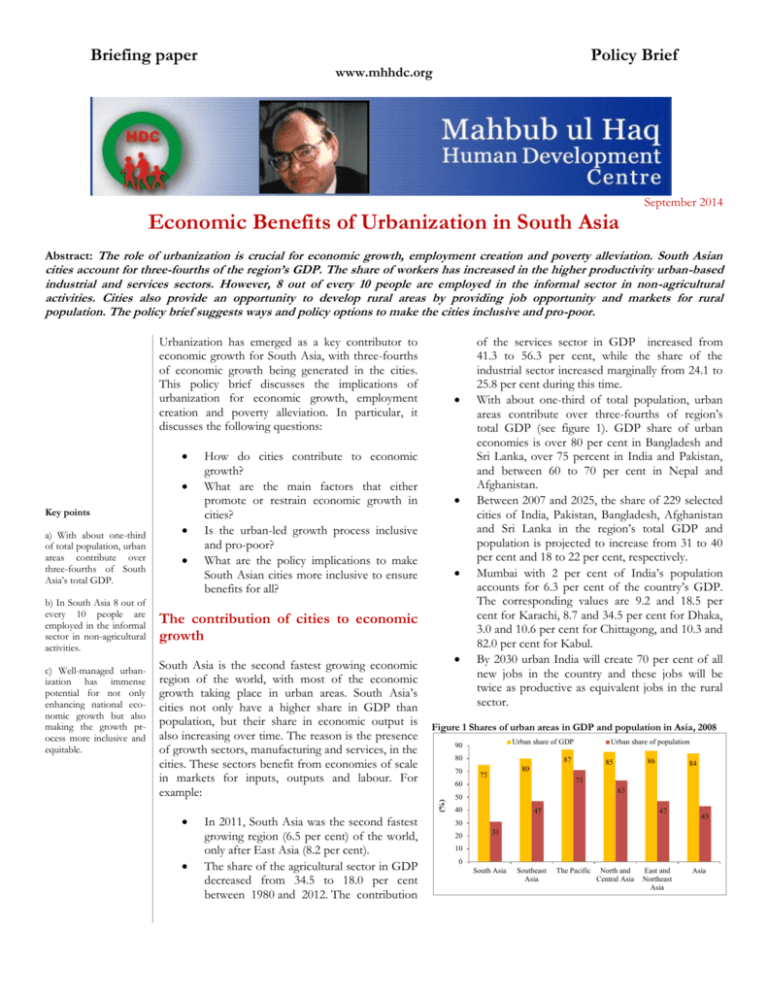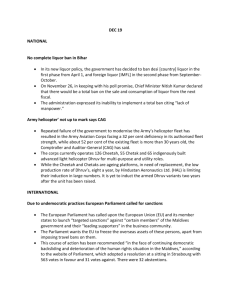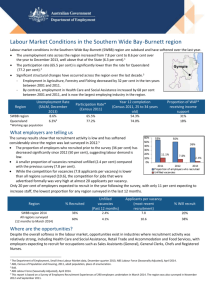Economic Benefits of Urbanization in South Asia
advertisement

Briefing paper Policy Brief www.mhhdc.org September 2014 Economic Benefits of Urbanization in South Asia Abstract: The role of urbanization is crucial for economic growth, employment creation and poverty alleviation. South Asian cities account for three-fourths of the region’s GDP. The share of workers has increased in the higher productivity urban-based industrial and services sectors. However, 8 out of every 10 people are employed in the informal sector in non-agricultural activities. Cities also provide an opportunity to develop rural areas by providing job opportunity and markets for rural population. The policy brief suggests ways and policy options to make the cities inclusive and pro-poor. Urbanization has emerged as a key contributor to economic growth for South Asia, with three-fourths of economic growth being generated in the cities. This policy brief discusses the implications of urbanization for economic growth, employment creation and poverty alleviation. In particular, it discusses the following questions: Key points b) In South Asia 8 out of every 10 people are employed in the informal sector in non-agricultural activities. c) Well-managed urbanization has immense potential for not only enhancing national economic growth but also making the growth process more inclusive and equitable. How do cities contribute to economic growth? What are the main factors that either promote or restrain economic growth in cities? Is the urban-led growth process inclusive and pro-poor? What are the policy implications to make South Asian cities more inclusive to ensure benefits for all? The contribution of cities to economic growth South Asia is the second fastest growing economic region of the world, with most of the economic growth taking place in urban areas. South Asia’s cities not only have a higher share in GDP than population, but their share in economic output is also increasing over time. The reason is the presence of growth sectors, manufacturing and services, in the cities. These sectors benefit from economies of scale in markets for inputs, outputs and labour. For example: Figure 1 Shares of urban areas in GDP and population in Asia, 2008 In 2011, South Asia was the second fastest growing region (6.5 per cent) of the world, only after East Asia (8.2 per cent). The share of the agricultural sector in GDP decreased from 34.5 to 18.0 per cent between 1980 and 2012. The contribution Urban share of GDP 90 80 70 Urban share of population 87 86 85 80 75 84 71 60 (%) a) With about one-third of total population, urban areas contribute over three-fourths of South Asia’s total GDP. of the services sector in GDP increased from 41.3 to 56.3 per cent, while the share of the industrial sector increased marginally from 24.1 to 25.8 per cent during this time. With about one-third of total population, urban areas contribute over three-fourths of region’s total GDP (see figure 1). GDP share of urban economies is over 80 per cent in Bangladesh and Sri Lanka, over 75 percent in India and Pakistan, and between 60 to 70 per cent in Nepal and Afghanistan. Between 2007 and 2025, the share of 229 selected cities of India, Pakistan, Bangladesh, Afghanistan and Sri Lanka in the region’s total GDP and population is projected to increase from 31 to 40 per cent and 18 to 22 per cent, respectively. Mumbai with 2 per cent of India’s population accounts for 6.3 per cent of the country’s GDP. The corresponding values are 9.2 and 18.5 per cent for Karachi, 8.7 and 34.5 per cent for Dhaka, 3.0 and 10.6 per cent for Chittagong, and 10.3 and 82.0 per cent for Kabul. By 2030 urban India will create 70 per cent of all new jobs in the country and these jobs will be twice as productive as equivalent jobs in the rural sector. 63 50 40 47 47 30 20 43 31 10 0 South Asia Southeast Asia The Pacific North and Central Asia East and Northeast Asia Asia Briefing paper Policy Brief www.mhhdc.org Factors that promote economic growth part of corporate activities in finance, production and trade. Bangalore and Hyderabad as hubs for information in cities Investment: Cities with a favourable investment environment are more likely to contribute to economic growth. The concentration of investment has been in and around major cities of the region such as Dhaka, Chittagong, Karachi, Lahore, Faisalabad, Bangalore, Mumbai, Colombo, etc. Overall, in South Asia the ratio of gross fixed capital formation and foreign direct investment as a percentage of GDP is one of the lowest in Pakistan and the highest in India. The failure of Pakistan is attributed to inadequate infrastructure, corruption, and poor law and order. In Pakistan, the top five constraints for urban formal sector firms are: electricity, corruption, theft, crime and disorder, and access to finance. About Mahbub ul Haq Human Development Centre Under the umbrella of Foundation for Human Development in Pakistan, Mahbub ul Haq Human Development Centre was set up in November 1995 in Islamabad, Pakistan by the late Dr. Mahbub ul Haq, founder and chief architect of UNDP Human Development Reports. With a special focus on South Asia, the Centre is a policy research institute and think tank, commited to the promotion of the human development paradigm as a powerful tool for informing people-centred development policy, nationally and regionally. Infrastructure: Improved infrastructure in cities contributes to economic growth. According to Pakistan’s Task Force Report on Urban Development, inadequate infrastructure has reduced urban GDP by 10 to 15 per cent with higher impact on small and medium enterprises. South Asia has invested only 3.5 to 4 per cent of GDP annually in infrastructure compared to 8 to 10 per cent in Vietnam during 2000-05, and 14.4 per cent of GDP in China in 2006. In Pakistan, the biggest infrastructural gaps are in energy, transport and water and sanitation, with severe implications for urban environment in terms of water and air pollution. Competitiveness: In the globalization era competition between countries, which mainly occurs between cities, has become dramatically intense. Mega-cities of South Asia like Mumbai, Kolkata, Karachi, Lahore, Colombo and Dhaka are struggling in competitiveness rankings. According to the Global Urban Competitiveness Report 2011, only four South Asian cities are in the top 300 globally competitive cities, while 16 cities are in the top 400 cities. According to the Economist Intelligence Unit, by 2025 Mumbai and Delhi are expected to improve their competitiveness positions significantly while some cities in Pakistan, Bangladesh, Sri Lanka and in India will be deteriorated further. The main determinants for poor competitiveness of South Asian cities are: inadequate planning, financing and development; weak business environment; poor collaboration among business units; and low labour productivity. Globalization: Exports of goods and services have become a significant source of income and employment in cities of South Asia. The cities which have specialized in certain products have benefitted from globalization. They are hosting a significant technology (IT) and software services, Dhaka as readymade garment (RMG) production centre, and Sialkot as hub for sports and surgical instruments are good examples. Several countries in the region are in the process of forming export processing zones (EPZs) in cities to benefit from globalization. Recently, the Government of Pakistan has planned to set up an EPZ in Faisalabad by offering a number of incentives to investors ranging from tax exemptions to reduction in import duties. City clusters: Industrial and services clusters have become important drivers of economic growth, employment creation and poverty reduction. The main determinants of city clusters are topography, skilled labour, climate, transportation and technological facilities. Such clusters have grown and serve as business hubs in several South Asian countries. Sialkot and Wazirabad in Pakistan as producers of surgical instruments and cutlery; and Ludhiana, Tiruppur, Agra and Palar Valley in India as producers of woolen knitwear, cotton knitwear, footwear and leather tanning are a few examples. In India, 14 clusters of cities are projected to account for 17 per cent of country’s population and 40 per cent of country’s GDP by 2030. Skilled labour: The success of IT and software sector in Bangalore and RMG sector in Dhaka is the result of two factors: presence of highly educated and skilled people and innovative entrepreneurs in India, and substantial public and private sector investment in Bangladesh. However, skilled individuals are very few in most cities. This deficiency, along with inadequate employment creation and mismatch between skills and jobs, has constrained economic growth in cities. In Pakistan and Sri Lanka, up to one-third of employed people are found to be either underor over-qualified for the work they do. More than one-third of the labour force in the region lacks any education at all. In Pakistan, 42 per cent of the labour force is illiterate, while 19 per cent have primary education, 32 per cent have secondary education and 7 per cent have tertiary education. Role of urbanization for inclusive and propoor growth Impact on employment creation Role of cities in increasing labour force in South Asia: In South Asia, the labour force will increase by 12 to 14 million per annum during the next two decades (between 2010 and 2030), accounting for about 40 per cent of the total new entrants to the global working age population. There is a need to create jobs for these people. This requires not only a higher and sustained economic growth but also to link economic growth with employment creation. The role of cities is crucial for this. Cities can pro- Briefing paper Policy Brief www.mhhdc.org vide an opportunity to increase economic growth and create employment opportunities. As the agricultural sector in the region already contains surplus labour, urban-based industry and services sectors have to create employment opportunities for urban residents as well as for rural migrants. The provision of relevant skills and the linkage of economic growth with employment creation is vital for this. women. The evidence can be seen from the growing garment sector in Bangladesh to call centres in India. However, women are working under exploitative conditions. In South Asia, 83 per cent of women’s non-agricultural employment is informal varying from 85 per cent in India and 76 per cent in Pakistan to 56 per cent in Sri Lanka. Figure 2 Share of informal employment in non-agricultural/urban employment, 2004-10 90 Job creation in South Asia: Between 2002-06 and 2007-11, GDP grew at an annual rate of 8.3 and 6.6 per cent while employment increased by only 2.3 and 1.1 per cent compared to about 3.6 and 3.7 per cent increase in labour productivity. Overall, GDP growth and labour productivity growth have been higher in 2000s compared to 1990s, while employment growth has been lower. A decrease in employment to population also shows jobless growth (see table 1). Table 1 GDP, employment and labour productivity (annual) growth in South Asia, 1992-2011 1992 199720022007-96 2001 06 11 GDP (%) 6.2 5.2 8.3 6.6 Employment (%) 2.3 2.2 2.3 1.1 Labour productivity (%) Employment to population ratio (average) 3.1 1.9 3.6 3.7 58.7 57.7 58.0 55.8 Informal sector employment in urban areas: Employment growth has taken place almost exclusively in the informal sector in urban areas which is characterized by the lack of legal and social protection. In developing countries, about 85 per cent of all new employment opportunities are created in the informal sector. The trend is similar in South Asia where 8 out of every 10 people are employed in the informal sector in nonagricultural activities, ranging between 74 per cent in Bangladesh to 84 per cent in India (see figure 2) Women’s employment: Female labour force participation rate as a percentage of male is one of the lowest in South Asia (40 per cent in 2011). However, in absolute terms women’s participation in labour force has increased over the last few decades. The demand for female workers has increased due to urbanization and globalization of markets and production systems that have created employment opportunities for 81 79 78 82 74 66 62 (%) 84 60 51 43 30 65 51 45 10 0 Role for rural development Urbanization provides an opportunity for rural development by providing jobs and markets for rural population. Jobs for rural migrants: Urban areas provide employment opportunities to rural residents who either migrate on a permanent basis or commute on a daily basis. This mobility enhances the welfare of migrants’ families. For instance, in Pakistan, in 2001 average income of working men and women improved by 1.8 and 2.4 times after migration to cities. The ratio of female to male earnings also increased from 62 to 85 per cent. Such earnings have links with rural livelihoods. Providing markets: Urban areas act as markets for products produced in rural farm and non-farm sectors. The resulting rural prosperity promotes urban markets in machinery, technology, banking, fertilizers, pesticides, etc. In different urban centres of Pakistan, urban areas have benefited rural residents not only by providing employment opportunities, but also by providing markets for the sale of their food products. For instance, Lahore and its surrounding districts; twin cities of Islamabad and Rawalpindi and their nearby cities of Jhelum, Chakwal and Attock; and Sialkot, Gujrat and Gujranwala are examples of this. The presence of highly developed urban centres also provides great opportunity for the development of non-farm sector in rural areas which absorbs surplus labour from the farm sector and decreases rural to urban migration. In South Asia, the contr- Briefing paper ibution of rural non-farm activities to rural household income ranges from about a third in Nepal and Pakistan to about twofifths in India to more than half in Sri Lanka and Bangladesh. 3. However, a note of caution is necessary here. Demand for land in the surrounding areas of cities has increased in the region to build residential areas, industrial clusters, transport corridors and for waste disposal. Such trends are not only reducing farm land but also affecting crop production. In Lahore, between 1972 and 2010 about 3,016 hectares of vast agricultural areas on the fringes of the city were converted for urban use annually. If the present land use policy and norms are not modified, the remaining total cultivated area of 52,332 hectares will be exhausted by 2030. Such trends have negative consequences for food production. For example, in Lahore the production of crops decreased significantly between 1986-87 and 2007-08 due to reduced arable land. 4. Policy recommendations to make the cities inclusive and pro-poor Well-managed urbanization has immense potential for not only enhancing national economic growth but also making the growth process more inclusive and equitable. South Asia has to consider urbanization as an opportunity to address issues of poverty, inequality, deprivation and underdevelopment. An approach based on Dr. Mahbub ul Haq’s philosophy of human development will facilitate economic growth, reduce income inequality as well as balance rural-urban development. Following are some policy recommendations: 1. Mahbub ul Haq Centre Lahore University of Management Sciences, Academic Block, Ground Floor, DHA, Opposite sector U Lahore Cantt, 54792 Pakistan. Tel: 042-35608000 ext. 2156 Fax: 042-35748713 Email: hdc@comsats.net. pk Website: www.mhhdc.org Policy Brief www.mhhdc.org 2. There is a need to link economic growth with job creation by boosting investment in labour-intensive sectors, encouraging small and medium enterprises and increasing social sector spending on health and education, as is exemplified from the success stories of East Asia and Bangladesh. Urban development policy must recognize the role of the urban informal sector towards incorporating it in the formal growth process in a substantial way. This requires the formation of well-designed and well-targeted programmes that can help informal sector workers to improve their income and working conditions. In this context, the access of the poor to land, credit and basic social services is crucial. 5. 6. Improve the quality of education starting from basic education to higher education and technical and vocational education and in-service training. Most importantly, link education with employment creation opportunities to address issues of mismatch of skills to jobs. Improve the competitiveness of urban-based industrial and services sectors by enhancing their technological competitiveness and innovation skills and guide them about global export and import opportunities. Address issues of energy, law and order, infrastructure, finance, and corruption to attract domestic and foreign investment. Ensure balanced rural and urban development based on balanced budgetary allocations for the provision of basic public services, and strong linkages between urban-based industrial and services sectors and rural farm and non-farm activities, as can be learned from the success of Chengdu city in China. Most importantly, the region needs to increase public investment in infrastructure for energy, water and sanitation, solid waste, transport, housing, and information and communications technology (ICT) services to ensure equity and environmental sustainability. This policy brief is drawn on the findings of Human Development in South Asia 2014: Urbanization: Challenges and Opportunities. The author, Nazam Maqbool, is a senior research fellow at Mahbub ul Haq Centre. Themes of the Report Development in South Asia 1997 1998 1999 2000 2001 2002 2003 2004 2005 2006 of Human The Challenge of Human Development The Education Challenge The Crisis of Governance The Gender Question Globalization and human Development Agriculture and Rural Development The Employment Challenge The Health Challenge Human Security in South Asia Poverty in South Asia: Challenges and Responses 2007 A Ten-Year Review 2008 Technology and Human Development in South Asia 2009 Trade and Human Development 2010/11 Food Security in South Asia 2012 Governance for People’s Empowerment 2013 Water for Human Development 2014 Urbanization: Challenges and Opportunities Briefing paper www.mhhdc.org Policy Brief




